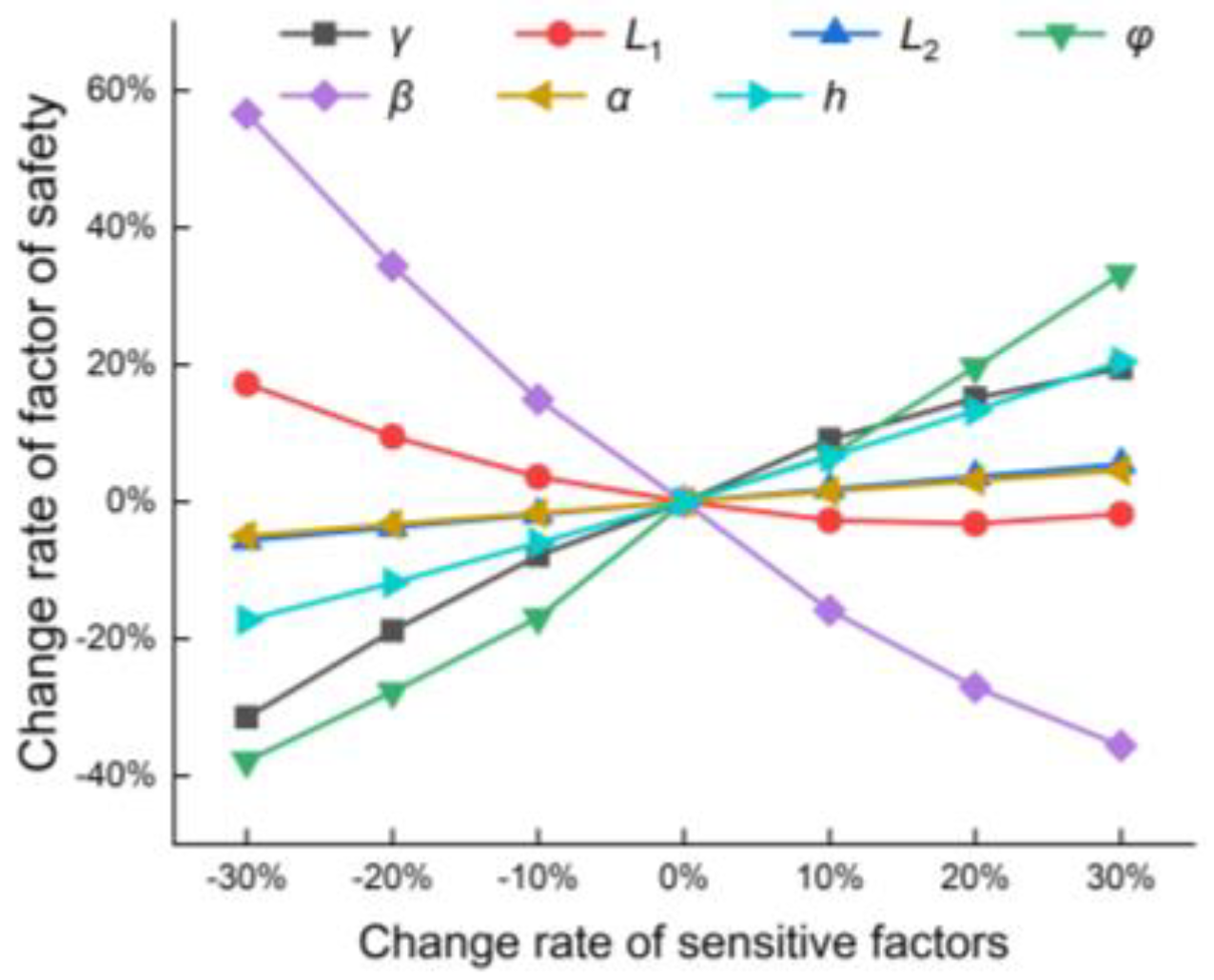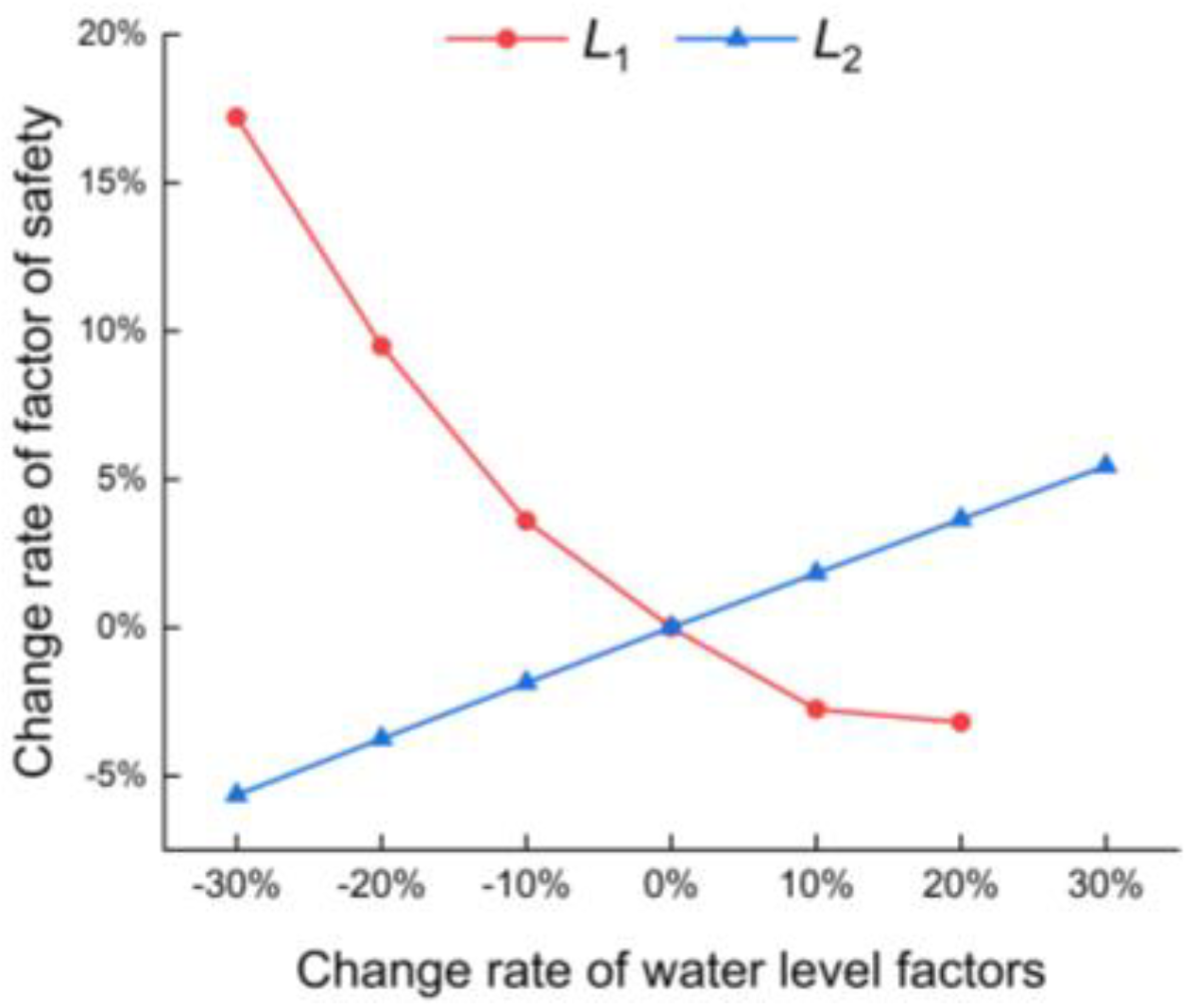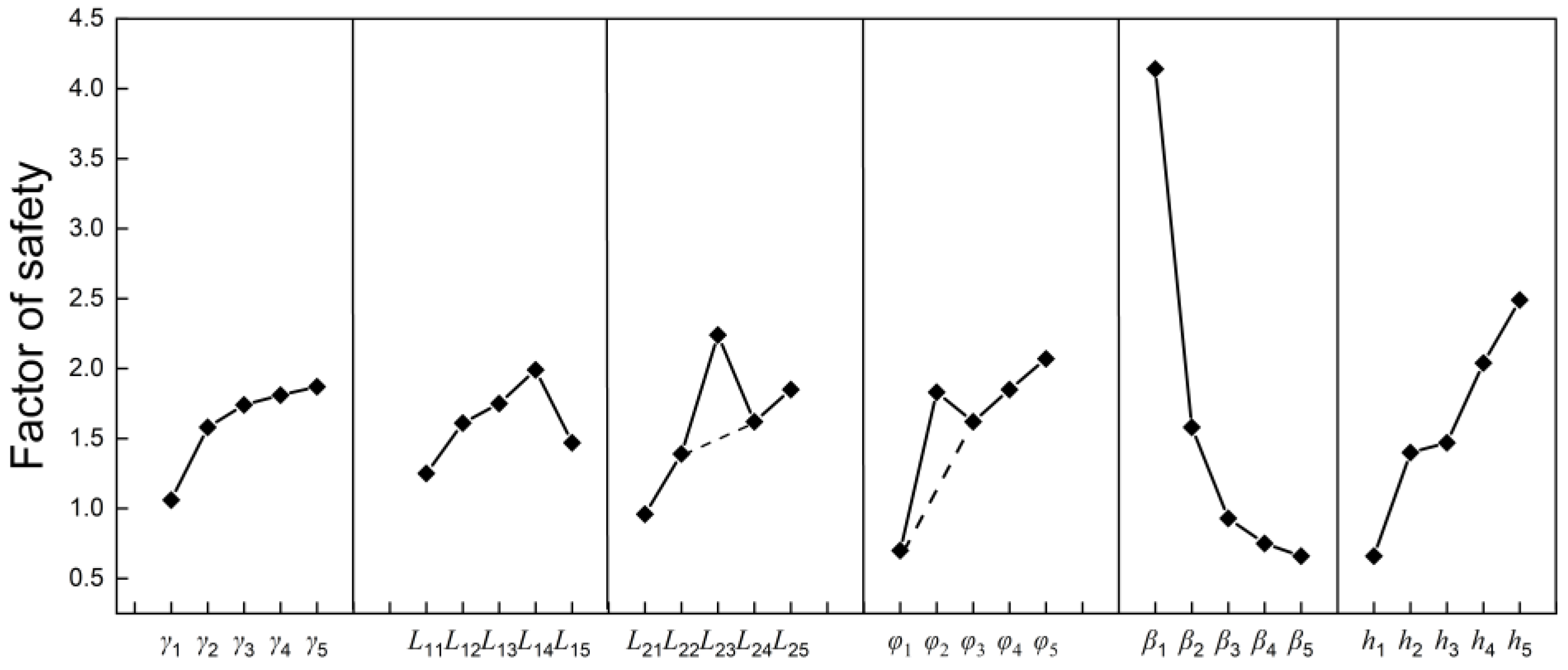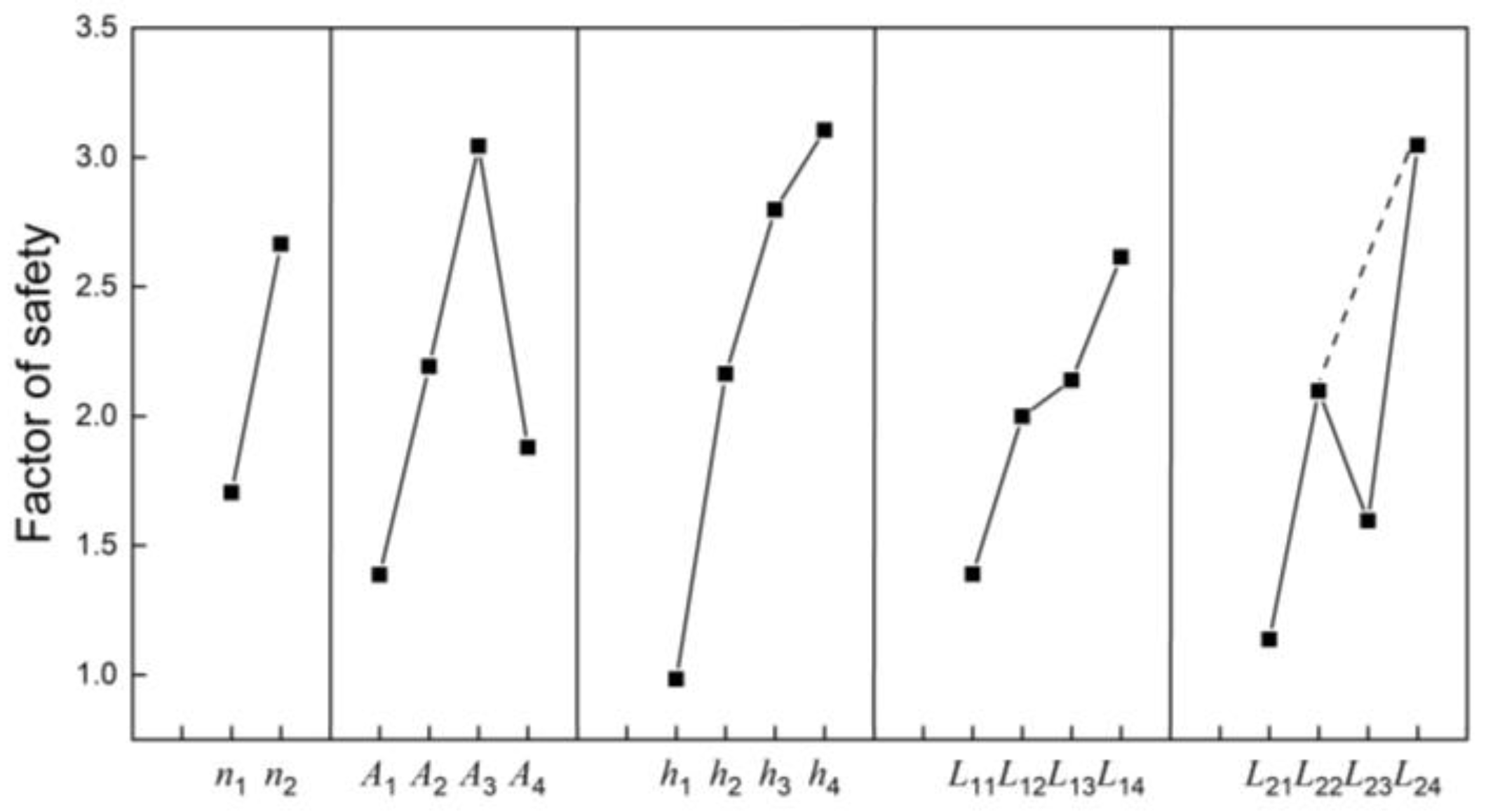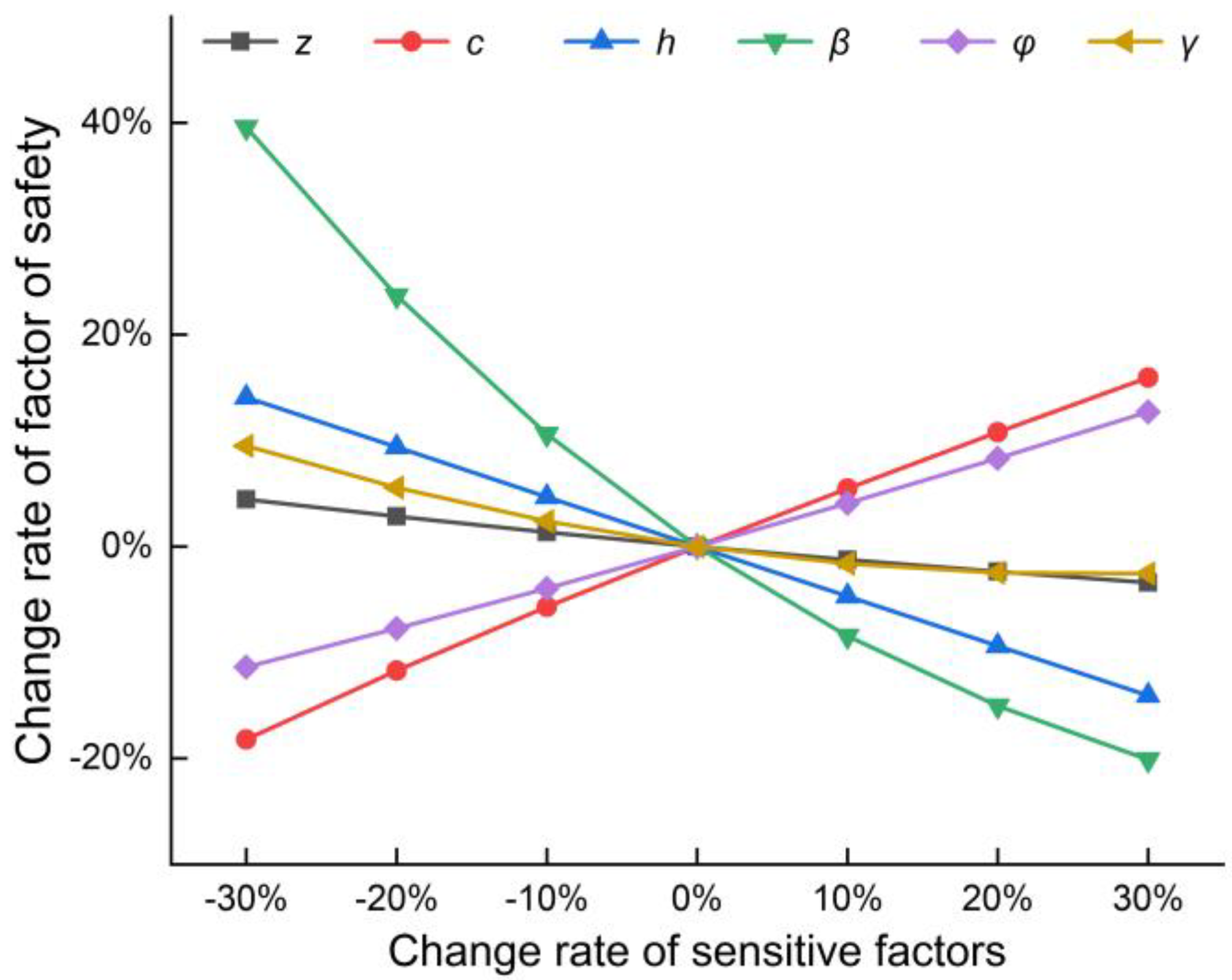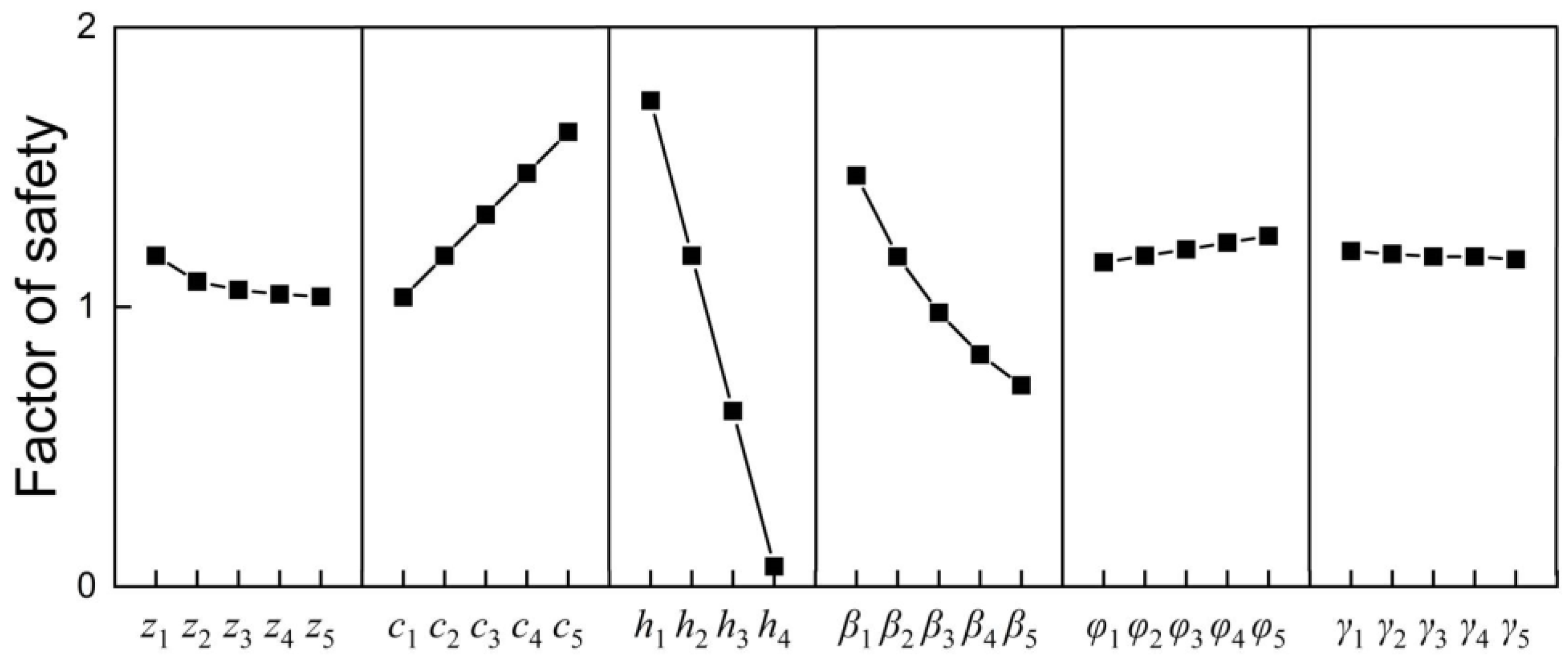1. Introduction
The fluctuation of reservoir water level, which is caused by heavy rainfall, water storage, and flood discharge, may result in the instability of slopes in hydraulic engineering. In 1959, a large-area landslide occurred upstream of the Zhexi reservoir in Hunan province, which was mainly triggered by the rapid rise of the water level [
1]. In October 1963, a major landslide occurred on the left bank of the Vajont reservoir in Italy, with a total volume of 240 million cubic meters, and 2600 people were killed [
2]. Since 2008, the water level of the Three Gorges Reservoir area in China has been tentatively impounded by 175 m. The reservoir experiences nearly 30 m of water level fluctuation, which has caused nearly 500 ancient landslides to be revived, and the deformation and instability have led to the occurrence of new landslides [
3]. Scholars and engineers have studied the causes, mechanisms, and characteristics of landslides, such as the Woshaxi, Qianjiangping, Shuping, and Quchi landslides, in the Three Gorges Reservoir area [
4,
5,
6,
7,
8]. It is widely considered that hydraulic factors such as atmospheric precipitation, fluctuation, and the change rate of the water level of the reservoir, as well as river wave erosion, etc., could reduce the stability of bank slopes, even leading to landslide disasters. Landslides often occur after long rainy periods due to the increase in the positive pore pressure on a potential sliding surface and the decrease in the stability of deeper slopes [
9,
10,
11]. If intense rainfall occurs or the water level of the reservoir fluctuates rapidly, shallow landslides can occur as the moisture content in the soil becomes close to saturation, resulting in a considerable reduction in soil strength [
12,
13]. According to the scale model based on the Liangshuijing landslide, slope failure mainly occurs in the drainage stage, and the stability of the reservoir bank slope would gradually deteriorate during the long-term cyclic operation of the Three Gorges Reservoir [
14]. Rainfall before an earthquake will increase the water content on the surface of the slope and reduce the strength of loess, causing a large displacement and deep cracks in the slope [
15]. In general, an earthquake causes permanent damage to the slope and secondary damage results from rainstorms after the earthquake [
16]. The rock slopes formed by the bedding structures of fractured rocks disturbed by human activities and subjected to heavy rainfall are liable to a loss of stability [
17]. The damage of high bedding rock slopes by flood discharge of atomized rain was studied based on the slope in the Baihetan Hydropower Station. The results showed that the failure modes of the bedding rock slope were of two types: sliding–fracturing (the first slip block) and fracturing–sliding (other blocks) [
18]. The long-term effects of rainfall recharge and the fluctuation of groundwater weaken the rock and soil, causing creep deformation and even landslides [
19]. Sui and Zheng [
20] studied the failure mode of soil slopes caused by drawdowns through transparent soil testing, dividing the process of the destabilization of coast slopes into two stages: surface sliding and overall sliding.
Not only hydrological factors but other factors, such as the properties of the slope itself (e.g., the inclination of the slope, the density, and cohesion of slope soil, etc.), also affect the stability of a slope [
21]. The key variables for slope stability and the thresholds of water can be determined by sensitivity analysis, which can help engineers to identify the key variables triggering landslides.
Sensitivity analysis involves studying the influence of factor changes on the outputs by changing the values of related factors. The purpose is to identify the sensitive factors that have an important influence on the outputs from many uncertain factors and to obtain the degree of influence of different factors on the outputs. Shallow landslides with a small thickness (generally less than 2 m) are easily induced by rainfall because frequent rainfall events determine the progressive infiltration of the rainwater to the deepest soil levels [
22]. It was found that the depth of soil and the inclination of the slope are the main controlling factors of slope stability, and vegetation roots can improve the stability of a slope [
23]. An infinite slope stability analysis (ISSA) model, involving some factors of shallow landslides, was established by Cross [
24]. The stability of shallow slopes is highly sensitive to the effective cohesion force (
c), piezometer height (
h), inclination of the slope (
β), and average sensitivity to soil depth (
z), and it is relatively insensitive to the effective angle of internal friction (
φ) and soil unit weight (
γ). The process sensitivity index, which was proposed by combining averaging methods and a variance-based global sensitivity analysis, was used to solve the problem; the model consists of multiple process-level sub-models [
25]. An ISS (infinite slope stability) model applied by Choo et al. [
26] showed that slope inclination and soil depth have the greatest influence on the output of the infinite slope stability model. Some researchers adopted the stacking ensemble technique, combining a radial basis function (RBF) with the random subspace (RSS), attribute selected classifier (ASC), support vector machine (SVM), least squares support vector machine (LS-SVM) [
27], cascade generalization (CG) [
28,
29], artificial neural network (ANN), gradient-boosting decision tree (GBDT) [
30], recurrent neural network (RNN), convolutional neural network (CNN) [
31], and other machine learning methods. Dai et al. [
32] integrated a hierarchical uncertainty framework with a variance-based global sensitivity analysis to deal with a large number of input factors, such as slope, aspect, elevation, curvature, slope length, and valley depth. Many other factors were used to develop the ensemble model’s package landslide samples [
33,
34,
35]. The seismic pseudo-static stability of a rock wedge was studied based on the nonlinear Barton–Bandis criterion. The sensitivity analysis showed that the parameters related to the strike of the joint plane have a greater influence than others [
36].
Since water level fluctuation is a critical trigger factor for a landslide, some slope stabilization techniques can be used to alleviate this problem. The controlling techniques for landslide prevention engineering include anti-slide pile and wall systems, surface and underground drainage systems, and prestress systems [
37]. Stabilizing piles are widely used for increasing the safety conditions of thrust-type slopes, which mainly control the deformation and failure process of the upper sliding mass. A stabilizing pile is a passive reinforcement measure [
38]. Based on the results of a model test and field test on stabilizing piles in China, the distribution functions of the landslide-thrust and the resistance of soil or rock have been deduced [
39]. Troncone et al. combined the water balance equation with the motion equation to evaluate and predict the rainfall-induced movements of landslides in the presence of stabilizing piles [
40]. Hu et al. established an in situ multi-field information monitoring platform to monitor the multi-field dynamic process of the Majiagou landslide with stabilizing piles. The monitoring results showed that the deformation of the experimental piles was influenced by the reservoir operation [
41]. Current drainage systems can be divided into surface water drainage systems and subsurface drainage systems [
42]. The drainage tunnel can control the decrease in the depth of the groundwater table and reduce the pore water pressure of landslides to promote the stability of slopes [
37,
43]. Based on the protection scheme of drainage, the groundwater level within zone II of the Jinpingzi landslide was lowered by 3.0–12.3 m, along with a decrease in the annual increment of the deformation in the same period [
44]. An anchor is a common prestress technology. It can be divided into the free section and the anchoring section. The free section refers to the area where the tension at the anchor head is transmitted to the soil. By prestressing the landslide, the anti-sliding force is increased, and the sliding force is reduced [
37]. According to the type of anchorage section, the anchor can be divided into a cylinder anchor and an expanded head anchor. An expanded head anchor does not need specific tools to expand the bottom and causes little disturbance to soil [
45]. The main influencing factors of the end-bearing force of the expander section are the buried depth of the expanded head (
h), the effective cohesion force (
c), and the internal friction angle (
ϕ) [
46]. An umbrella anchor is a new type of expanded head anchor. It was proposed by Smith in 1966, and its self-expanding property remarkably improved the uplift bearing capacity [
47,
48]. The sensitivity analysis of an umbrella-anchored rock slope under water storage conditions showed that the order of the sensitivity on the uplift-bearing capacity is the inclination of strata, amount of umbrella anchors, and water content [
49]. These results are useful to evaluate the landslide sensitivity in a certain area, which can guide landslide disaster prevention.
In the study of the influence of hydraulic factors on slope stability, the fluctuations of the reservoir water or the fluctuations of the groundwater level are monitored to evaluate the slope stability. Viratjandr and Michalowski [
50] proposed a model of slope stability that considers the effect of reservoir water level and groundwater level, which can be used for sensitivity analysis. Few researchers have considered anchoring factors in the analysis of slope stability, especially the umbrella anchor. This study aimed to conduct a sensitivity analysis on the stability of umbrella-anchored sand and clay slopes under the fluctuation of surface and groundwater levels.
2. Methods
Landslides are caused by a complex array of factors. To assess the sensitivity of various factors to sand and/or clay slopes, it is necessary to build models that consist of factors affecting slope stability.
According to the stability formula of cohesionless and dry slopes:
where
F is the factor of the safety of the slope,
W is the weight of the slip body (N),
β is the slope gradient (°), and
φ is the internal friction angle of the soil (°).
An improved slope stability sensitivity analysis (ISSSA) model that takes anchoring factors into consideration in umbrella-anchored slopes was presented based on a model (Equation (2)) proposed by Viratjandr and Michalowski [
50], reflecting the factor of safety of a sand slope under water level fluctuation.
where
γ is the weight of soil (kN/m
3);
γω is the weight of water (kN/m
3);
H is the slope height (m);
β is the inclination of the slope (°); and and
L1 and
L2 are the levels of water in the reservoir and the slope measured from the crown level (m), respectively.
The latter part, except for tan
φ in Equation (2), could be regarded as a coefficient of multi-factor slope safety, which is related to the fluctuation of the water level (
Figure 1).
θ is the assumed angle of failure surface.
Then, we can add anchoring force
T, and assume that the angle between the anchoring force and the normal line of slope surface is
α:
The uplift-bearing capacity of the umbrella anchor can be divided into three parts: the side friction resistance between the ordinary anchorage section and surrounding soil
R1, the side friction resistance between the expansion section and surrounding soil
R2, and the end-bearing force of the expanded section
R3 [
51]. In other words, the uplift-bearing capacity can be expressed as:
The umbrella anchor’s
R3 is much larger than its
R1 and
R2, so only the
R3 is considered [
51].
where
A is the projected area of the anchor along the direction of force (m
2),
σ is the positive pressure strength of soil acting on the expansion end (kPa),
ξ is the coefficient of lateral pressure, which is equivalent to Rankine’s active earth pressure coefficient
Ka,
ξ = (0.5–0.95)
Ka,
K0 is the static earth pressure coefficient of soil around the fixed section,
Kp is Rankine’s passive earth pressure coefficient of soil,
h is the buried depth of umbrella anchor (m),
ρ is the density of soil (kg/m
3), and
c is the cohesion of soil (kPa).
4. Summary and Conclusions
The fluctuations of the reservoir water level play a pivotal role in inducing slope failures [
53]. In this paper, the formula of the factor of safety of sand slopes under water level fluctuation was improved by adding anchoring factors. Then, the sensitivity of anchored sand and clay slopes under water level fluctuations was analyzed. A sensitivity order of related factors and the corresponding main control factors of the safety of slopes was obtained through an ISSSA model. Case 2 considered that the anchoring system of the umbrella anchor is formed with the surrounding cementation, and the effect of the umbrella anchor is directly substituted as the enhancement coefficient (
m,
n,
l), which is different to Case 1 to some extent, so the sensitivity order of a few factors is different. The order showed that the main controlling factors for the stability of the anchored sand slope under the fluctuation of the water level are the slope inclination and the layout density of the anchors (the number of umbrella anchors arranged in the vertical direction of the slope within the unit width). The water head height and slope inclination are the main controlling factors for the stability of the Cangjiang bridge–Yingpan slope.
With an increase in the anchorage angle α, the factor of safety will increase at first and then decrease. In other words, there is an optimum anchorage angle that has the greatest influence on slope stability. The angle should be in the range of 25–45 degrees.
The slope will be more stable when the factors of surface and groundwater level change synchronously. If a single water level factor changes suddenly in a short time, this will easily lead to slope instability, and a sudden drop in water level is more likely to cause a landslide. If the surface water level is less than 10% of the slope height and the surface water level rises sharply, due to the influence of hysteresis, the factor of safety will first increase and then decrease. When the surface water level is at 20%~30% of the slope height, the fluctuation of water level has the greatest influence on the factor of safety. When the water level factor fluctuates greatly, we should pay attention to the slope situation and implement corresponding measures in a timely manner in order to prevent the occurrence of landslide disasters.
There are some limitations in this work; for instance, the discussion on the influence of water level fluctuation factors on the factor of safety is mainly based on sand slopes. Moreover, the comprehensive influence of the fluctuation of the surface and groundwater level factors on the factor of safety should be analyzed for the clay slope. Due to the limitation of the model conditions, the sensitivity analysis did not consider the influence of factors such as the speed of water level changes and the groundwater seepage channels on slope stability.


